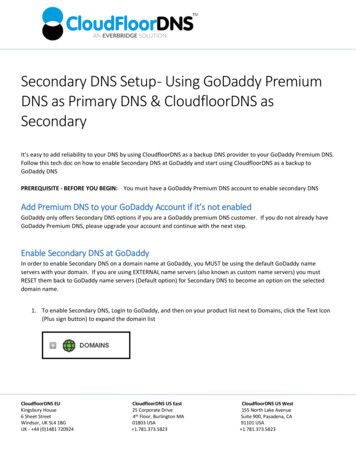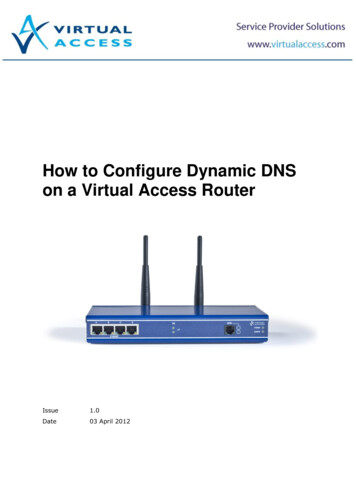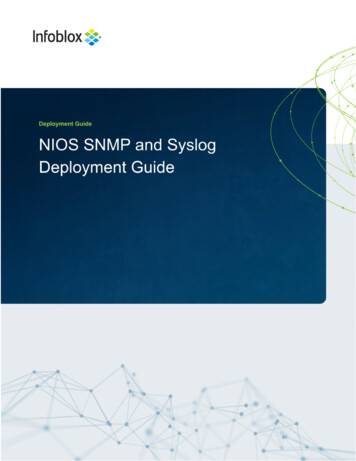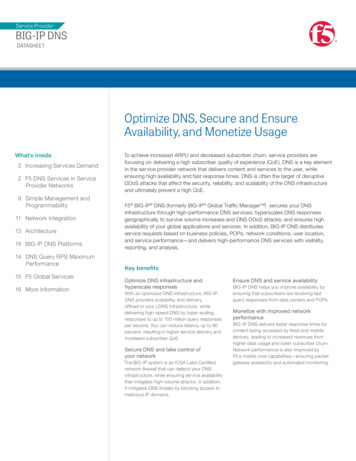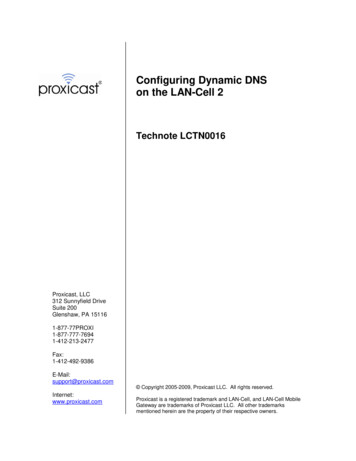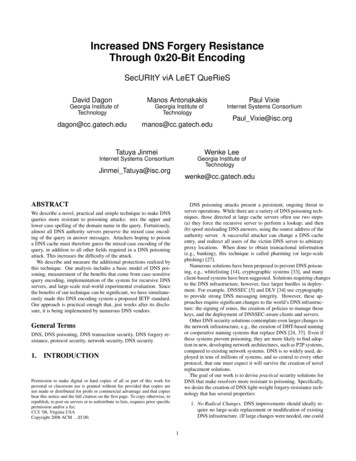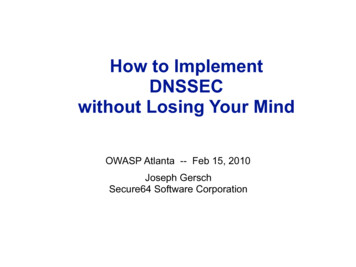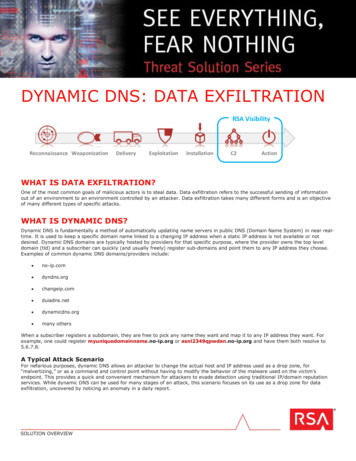
Transcription
DYNAMIC DNS: DATA EXFILTRATIONRSA VisibilityReconnaissance ionWHAT IS DATA EXFILTRATION?One of the most common goals of malicious actors is to steal data. Data exfiltration refers to the successful sending of informationout of an environment to an environment controlled by an attacker. Data exfiltration takes many different forms and is an objectiveof many different types of specific attacks.WHAT IS DYNAMIC DNS?Dynamic DNS is fundamentally a method of automatically updating name servers in public DNS (Domain Name System) in near realtime. It is used to keep a specific domain name linked to a changing IP address when a static IP address is not available or notdesired. Dynamic DNS domains are typically hosted by providers for that specific purpose, where the provider owns the top leveldomain (tld) and a subscriber can quickly (and usually freely) register sub-domains and point them to any IP address they choose.Examples of common dynamic DNS domains/providers include: no-ip.com dyndns.org changeip.com duiadns.net dynamicdns.org many othersWhen a subscriber registers a subdomain, they are free to pick any name they want and map it to any IP address they want. Forexample, one could register myuniquedomainname.no-ip.org or asnl2349qpwdan.no-ip.org and have them both resolve to5.6.7.8.A Typical Attack ScenarioFor nefarious purposes, dynamic DNS allows an attacker to change the actual host and IP address used as a drop zone, for“malvertizing,” or as a command and control point without having to modify the behavior of the malware used on the victim’sendpoint. This provides a quick and convenient mechanism for attackers to evade detection using traditional IP/domain reputationservices. While dynamic DNS can be used for many stages of an attack, this scenario focuses on its use as a drop zone for dataexfiltration, uncovered by noticing an anomaly in a daily report.SOLUTION OVERVIEW
(3) Attacker can quickly change hosting IP addresses andupdate dynamic DNS to ensure malware can stillcommunicate(1) Attacker registers a dynamic DNSdomain and points it to an IP addresshosting a drop ip.org ATADATA(4) Malware used toupload/download dataregardless of change in IPaddress(2) Malware programmed totalk to random123.no-ip.orgFigure 1 – Attacker Use of Dynamic DNS DomainDetection and ResponseDetection of traffic or logs containing access to and from dynamic DNS domains can be done by traditional tools such as IDS/IPS,Firewalls, and SIEM, however depending on the nature of the attack none of those tools can provide full visibility into the associatednetwork traffic, particularly in the case of data ariesVariesTraffic to DynamicDNS DomainsData ExfiltrationAV/FW/IDS/IPS:Traditional SIEM:RSA SecurityAnalytics:No visibilitySOLUTION OVERVIEWPartial Visibility/SignatureFull Visibility
DYNAMIC DNS/DATA EXFILTRATION VISIBILITY WITH RSA SECURITYANALYTICS FOR PACKETS AND LOGSRSA Security Analytics allows for the reporting of all network, log, net flow and endpoint data from a single interface. By leveraging afeed of known dynamic DNS top level domains, RSA Security Analytics can produce a rich report summarizing all activity that hasbeen seen both on the wire (packets) or from various devices in the network such as proxies and firewalls (logs). In addition to justtagging traffic to and from dynamic DNS domains, RSA Security Analytics can add valuable business and asset context to help ananalyst sift through the noise. In this case, the analyst can see the dynamic DNS traffic split by asset criticality and function:SOLUTION OVERVIEW
Figure 2 – Sample Dynamic DNS ReportFrom this report, the analyst can prioritize and drill in to the most interesting data points to investigate further. In this particularreport, the analyst focuses in on data uploads to dynamic DNS domains from critical servers (which should never happen in thisenvironment):Figure 3 – Dynamic DNS Session from a File ServerDirectly from the report, the analyst can drill down to gain insight into the specific sessions:SOLUTION OVERVIEW
Figure 4 – Drill from Dynamic DNS Report into Sessions from a File ServerThis looks suspicious enough on its own, but by drilling once more, the analyst can see the reconstructed network session, and inturn extract any files that had left the environment:Figure 5 – HTTP Upload of Files to a Dynamic DNS Host from a Critical ServerGoing one step further, the analyst can download and extract the archive and see the actual company information that has left theenvironment. By understanding the business impact, proper steps can now be taken to handle the incident further:SOLUTION OVERVIEW
Figure 6 – Extract Files to See what has Left the OrganizationFigure 7 – Extracted Schematic DiagramREFERENCESDynamic DNS: http://en.wikipedia.org/wiki/Dynamic DNSList of common dynamic DNS domains: http://mirror1.malwaredomains.com/files/dynamic dns.txtC2 using Dynamic DNS: http://info.opendns.com/rs/opendns/images/OpenDNS SecurityWhitepaper-DNSRoleInBotnets.pdfCyber Kill Chain: mlSOLUTION OVERVIEW
Dynamic DNS is fundamentally a method of automatically updating name servers in public DNS (Domain Name System) in near real-time. It is used to keep a specific domain name linked to a changing IP address when a static IP address is not available or not desired. Dynamic DNS domains are typically hosted by providers for that specific purpose .
